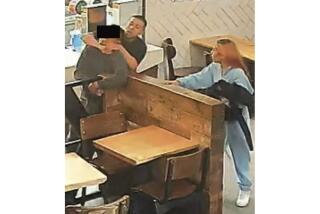Mexico Still Seen as Fugitive Friendly
They were audacious criminals who like many before them found a perfect place to disappear -- among tourists enjoying the beaches of Mexico, where no one cared about their last names or their histories.
While on the lam, Max Factor great-grandson and convicted rapist Andrew Luster was so confident that he stayed at a Puerto Vallarta motel just steps from the headquarters of Mexican police who took him in custody June 18. He surfed, picked up girls and drank tequila.
The Rev. Austin Peter Keegan, a former San Francisco priest who was captured in March -- also in Puerto Vallarta -- had been receiving Social Security payments through an ATM at a local pharmacy.
David Scott Ghantt lived for five months near the alabaster-colored beaches of Playa del Carmen after stealing $17 million in a North Carolina armored-car heist. He paid for a $90-a-day room and bought Jack Daniels with money wired from his co-conspirators, said Brian Whisler, who helped nab Ghantt with a wiretap in 1998 and successfully prosecuted the case for the U.S. attorney’s office.
And Father Siegfried Widera, one of the most-wanted sex-crime fugitives in North America, was driving with an expired Mexican car permit down Mazatlan’s busiest streets before he was captured -- and then committed suicide -- in May.
Their recent high-profile captures show Mexico wants to change its image as a place where anyone can hide. But the lives of recent U.S. fugitives suggest Mexico will have to work hard to overcome a reputation that dates back decades and has been glorified by movies.
“It has always been [Hollywood’s way to show that] the Sundance Kid crosses into Mexico and disappears,” said John Mabrey, an expatriate and physician who has lived in Puerto Vallarta for two decades.
About once a month, there is news in a Mexican beach town of some U.S. citizen being arrested. “This is just a place with beautiful beaches and tourist amenities. It’s attractive to fugitives who are trying to blend in,” said Sebastian Zavala, Puerto Vallarta police spokesman.
Marco Roberto Juarez, a spokesman for the state attorney general’s office in Puerto Vallarta, said tourist towns along the coast, where U.S. citizens blend in easily, are particularly attractive to fugitives. “Puerto Vallarta is a tourist center ... so anybody can go unnoticed,” he said.
And “Mexico is a place where anonymity is easy to keep,” Mexican extradition expert and lawyer Ricardo Sodi said.
The benefits of hiding in Mexico begin at the border. U.S. citizens with a driver’s license or other government-issued identification do not even need a passport to enter. In a country where many government offices lack fax machines or computers, there is no way to check whether visitors are criminals when they fill out cards for tourists visas, nor is there a way to perform background checks when U.S. citizens apply for Mexican residency.
Law enforcement officials on both sides of the border acknowledge that corruption, which allows fugitives to buy their way out of problems, still exists in Mexico.
At the beach resorts, where many of the fugitives have been found, many hotels don’t even ask for guests’ names or credit cards. Expatriates don’t ask for last names or phone numbers of new friends. They don’t press for details about the past, yet know that some of those around them may be running from something.
Canadian Wilfred Ziegler knew Widera -- suspected of molesting boys years ago in Wisconsin and Orange County -- for months before his capture and had an inkling the priest might be hiding. Ziegler and his friends couldn’t understand why Widera would not return to the United States and reenter Mexico to keep his six-month Mexican car permit valid.
“We knew something was up. But we left it alone,” said Ziegler, who knew Widera only as “Fred,” and never even thought to ask him his last name.
However, authorities on both sides of the border say Mexican tolerance of U.S. fugitives is lessening. Practices began changing with the 1994 North American Free Trade Agreement and accelerated under President Vicente Fox, U.S. and Mexican officials agree.
“Mexico wants to be a team player. It’s an extreme change,” said Sodi, the Mexican extradition expert. “Public opinion is more important now than ever and people are tired of these criminals.”
Enrique Zepeda Vazquez, a Los Angeles-based representative of the Mexican attorney general, said new computers, increased personnel and higher salaries in the Mexican justice department have led to more captures.
“We are trying to change the image but our accomplishments are often forgotten or overshadowed by what comes out in a movie, or a cliche,” Zepeda said. “We are trying to publicize our efforts more.”
In a June 25 news conference, Mexican Atty. Gen. Rafael Macedo de la Concha said 200 foreigners wanted in other countries were arrested and removed from the country in 2002, up from 160 in 2001. This year, 117 have been captured.
U.S. federal officers are searching for hundreds of people wanted for crimes including robbing banks, trafficking drugs and taking children who are part of custody disputes, FBI spokeswoman Laura Bosley said. The U.S. Marshals Service opened an office in Mexico in 2001.
“Mexico definitely does not want to be a haven for criminals.... They will readily expel people in the country illegally and hand them over to us. They do not want felons in their country,” said David Lindsay, officer in charge of the Los Angeles Police Department Fugitive Warrants Section.
Among those recently captured include James Williams, 32, of Stone Mountain, Ga., who was found in Acapulco in May after the FBI received a tip about his whereabouts. Williams had been charged with conspiracy to possess with intent to distribute cocaine and crack cocaine. Jesse Rosillo, a Kansas native wanted on charges of homicide and drug trafficking, was captured in Puerto Vallarta in May. Christian Longo, accused of killing his wife and three children, was found living in a grass hut on a beach near Cancun in January 2002.
News about fugitives spreads faster with the help of the Internet. Take the case of Timothy Joe Mobly. Known as the “Internet Rapist,” because he pleaded guilty to raping two women he met online, Mobly was reported to authorities by a girlfriend in Mexico who saw his photograph on the FBI’s Web site in 2001.
Fugitives also are spotted on the “America’s Most Wanted” television show, which is broadcast in parts of Mexico. Tips have helped catch 81 international fugitives, including 26 in Mexico, spokeswoman Kim Newport said. There have been 754 fugitives apprehended from tips since the show’s inception, she added.
During the early stages of the manhunt for Luster, his story was featured on “America’s Most Wanted.”
But it was the FBI’s Web site that ultimately helped lead to his capture. A couple he befriended in the small town of Costa Custodio were tipped about Luster’s background so they logged on to the federal agency’s Web site, where they found a photo of Luster, who they knew as David Carrera.
The couple contact authorities as well as a bounty hunter about their discovery. The bounty hunter eventually captured Luster on a Puerto Vallarta street on June 18.
Luster, the 39-year-old great-grandson of cosmetics legend Max Factor, fled the United States in January during his trial in Ventura County on charges of drugging and raping three women.
He was convicted in absentia and sentence to 124 years in prison.
Authorities are uncertain exactly where Luster hid out initially after fleeing but evidence found after his arrest indicated he had been in Mexico since at least April, crisscrossing the coastal villages and resorts near Puerto Vallarta.
He is now serving his sentence at Wasco State Prison in Kern County.
Despite the new technology, cooperation is strained by Mexico’s Supreme Court 2001 decision forbidding the extradition of any person facing the death penalty or life sentences. Los Angeles officials have called on President Bush to renegotiate the extradition treaty with Mexico to return 60 murder suspects, including Jorge “Armando” Arroyo Garcia, a Mexican national who was illegally in Irwindale when he allegedly shot and killed L.A. County Sheriff’s Deputy David March.
In a move that bypasses the extradition issue, Mexican authorities more frequently hand fugitives over to their immigration department, where they can be removed from the country on the grounds they are in Mexico without proper documents. That is what happened to Luster.
Many U.S. authorities say the level of cooperation depends on the workload and priorities of the Mexican agency that is asked to help. For example, Douglas Bachert, a deputy U.S. marshal from Milwaukee, said he sent a tip two years ago to Baja California officials about Randy Yager, a motorcycle gang member wanted on racketeering charges. He is still waiting for a response.
“We just hope that by the time they get to it,” Bachert said, “the tip is still good.”
*
Researcher Cecilia Sanchez Vidal of The Times’ Mexico City bureau contributed to this report.
More to Read
Sign up for Essential California
The most important California stories and recommendations in your inbox every morning.
You may occasionally receive promotional content from the Los Angeles Times.










